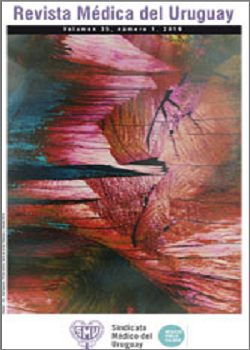Neurofibromatosis orbitotemporal gigante
Resumen
La neurofibromatosis orbitotemporal es una enfermedad progresiva que comienza en la infancia y puede generar importantes alteraciones morfológicas y funcionales. Presentamos el caso de un paciente adulto con diagnóstico de neurofibromatosis orbitotemporal gigante, en el cual se realizó un tratamiento mediante embolización preoperatoria y resección quirúrgica con el fin de disminuir el tamaño tumoral.
Citas
(1) Kapur S, Bentz ML. Pediatric tumors. En: Rodriguez ED, Losee JE, eds. Craneofacial, head and neck surgery and pediatric plastic surgery. 3rd ed. London: Elsevier- Saunders, 2013:877-92.
(2) Ferner RE, Gutmann DH. Neurofibromatosis type 1 (NF1): diagnosis and management. En: Said G, Krarup C, eds. Peripheral nerve disorders. (Handbook of Clinical Neurology, vol 115). Amsterdam: Elsevier, 2013: 939-55.
(3) Lee V, Ragge NK, Collin JR. The surgical management of childhood orbito-temporal neurofibromatosis. Br J Plast Surg 2003; 56(4):380-87.
(4) Havlik RJ, Boaz J. Cranio-orbital-temporal neurofibromatosis: are we treating the whole problem? J Craniofac Surg 1998; 9(6):529-35.
(5) Jackson IT, Carbonnel A, Potparic Z, Shaw K. Orbitotemporal neurofibromatosis: classification and treatment. Plast Reconstr Surg 1993; 92(1):1-11.
(6) Latham K, Buchanan EP, Suver D, Gruss JS. Neurofibromatosis of the head and neck: classification and surgical management. Plast Reconstr Surg 2015; 135(3):845-55.
(7) Hirbe AC, Gutmann DH. Neurofibromatosis type 1: a multidisciplinary approach to
care. Lancet Neurol 2014; 13(8):834-43.
(8) Katowitz WR, Katowitz JA. Orbitofacial neurofibromatosis 1: current medical and surgical management. En: Guthoff RF, Katowitz JA, eds. Essentials in ophthalmology. Oculoplastics and Orbit. Berlin: Springer, 2010:79-92.
(9) Li J, Lin M, Shao C, Ge S, Fan X. Blepharoplasty techniques in the management of orbito-temporal neurofibromatosis. J Plast Reconstr Aesthet Surg 2014; 67(11):1496-501.
(10) Oderich GS, Sullivan TM, Bower TC, Gloviczki P, Miller DV, Babovic-Vuksanovic D, et al. Vascular abnormalities in patients with neurofibromatosis syndrome type I: clinical spectrum, management, and results. J Vasc Surg 2007; 46(3):475-84.
(11) Littlewood AH, Stilwell JH. The vascular features of plexiform neurofibroma with some observations on the importance of pre-operative angiography and the value of pre-operative intra-arterial embolisation. Br J Plast Surg 1983; 36(4):501-6.
(12) Tomei KL, Gupta V, Prestigiacomo CJ, Gandhi CD. Spontaneous hemorrhage of a facial neurofibroma: endovascular embolization before surgical intervention. J Craniofac Surg 2013; 24(5):e514-7.
(13) Nair S, Gobin YP, Leng LZ, Marcus JD, Bilsky M, Laufer I, et al. Preoperative embolization of hypervascular thoracic, lumbar, and sacral spinal column tumors: technique and outcomes from a single center. Interv Neuroradiol 2013; 19(3):377-85.













